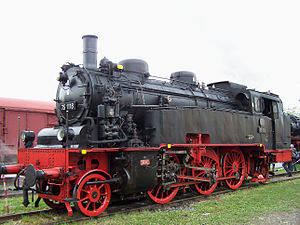Baden VI c
| Baden VI c DRG Class 75.4,10–11 | |||||||||||||||||||||||||||||||||||||||||
|---|---|---|---|---|---|---|---|---|---|---|---|---|---|---|---|---|---|---|---|---|---|---|---|---|---|---|---|---|---|---|---|---|---|---|---|---|---|---|---|---|---|
 DB 75 1118 at Meiningen Steam Locomotive Works (2007) | |||||||||||||||||||||||||||||||||||||||||
| |||||||||||||||||||||||||||||||||||||||||
| |||||||||||||||||||||||||||||||||||||||||
| |||||||||||||||||||||||||||||||||||||||||
| |||||||||||||||||||||||||||||||||||||||||
The first steam locomotives of the Baden Class VI c were delivered in 1914 by the Maschinenbau-Gesellschaft Karlsruhe for service in southwestern Germany with the Grand Duchy of Baden State Railway (Großherzoglich Badische Staatsbahn).
Design
[edit]Their design benefited from experience with the Baden VI b steam engines, but they were a fundamentally different class with a superheater, new running gear with larger wheels and a longer, fixed wheelbase. The boiler was pitched higher, and the double steam dome was done away with, along with its connecting pipe.
Service
[edit]The Grand Duchy of Baden State Railway procured a total of 135 of these engines between 1914 and 1921 in nine batches. After the end of the First World War, 15 locomotives had to be given away to France and 13 to Belgium as part of the reparations required under the terms of the Versailles Treaty.[1] The French locomotives went to the Chemins de fer de l'État who numbered them 32-901 to 32-915;[2] they were retired from service by 1945. The Belgian locomotives went to the État-Belge, who added 6000 to their Baden numbers; after a few years they went the Chemins de fer Prince-Henri (PH) who renumbered them 251–263.
The remaining 107 went to the Deutsche Reichsbahn. The lighter units of the first seven series were grouped into DRG Class 75.4, the heavier vehicles with a reinforced locomotive frame of the last two series were designated as DRG Class 75.10-11.
After the Second World War 66 Class VI c engines went into the Deutsche Bundesbahn, where they were stationed at various locomotive depots including Freiburg, Offenburg, Radolfzell, Singen, Waldshut, Karlsruhe and Villingen.[3]
The 13 Luxembourg locomotives had been taken over by the Deutsche Reichsbahn during the war; they had been renumbered 75 1121 to 75 1133. Eleven were returned to PH's successor, Société Nationale des Chemins de Fer Luxembourgeois (CFL), who renumbered them 3501 to 3513, omitting 3506 and 3509.
Four locomotives, 75 402, 404, 460, 493, were found by the SNCF in Alsace and taken into stock as 1-131.TX., keeping the last 3 digits of their Deutsche Reichsbahn number.
Withdrawal
[edit]In France, the SNCF had retired 3-131.TB 901 to 915 (the former État locomotives) by 1945; although one, 3-131.TB.909, was retained as a static instructional locomotive until 1967.[2] The 131.TX locomotives lasted until 1952.[4]
In Luxembourg, the CFL retired its 3500-series between 1957 and 1963.
In 1967 the last one serving with the Bundesbahn, number 75 1118, was retired.[5] The Deutsche Reichsbahn in East Germany still had some of these engines working at that time.
Preserved
[edit]
Number 75 1118 is operated today by the Ulmer Eisenbahnfreunde ('Ulm Railway Friends') on the branch line from Amstetten to Gerstetten[3] about 20 kilometres northwest of Ulm.
See also
[edit]References
[edit]- ^ Obermayer, Horst J. (January 2001). "Typenblätter, Baureihen 60-98". Eisenbahn Journal (in German). Band No. 2. p. 51, paragraph 1.
- ^ a b Davies 2001, p. 37.
- ^ a b "75 1118, die badische VIc". Ulmer Eisenbahnfreunde (in German).
- ^ Davies 2003, p. 81.
- ^ Obermayer, Horst J. (January 2001). "Typenblätter, Baureihen 60-98". Eisenbahn Journal (in German). Band No. 2. p. 51, paragraph 3.
- Davies, John (August 2001). Chemins de fer de l'État Locomotive List 1878–1938. Woodbridge, Queensland: Dr. John Davies. ISBN 0-7316-8442-7.
- Davies, John (November 2003). Société Nationale des Chemins de fer Français Locomotive List 1938–1975. Woodbridge, Queensland: Dr. John Davies. ISBN 0-9585541-2-9.
- Hütter, Ingo (2021). Die Dampflokomotiven der Baureihen 60 bis 91 der DRG, DRB, DB, und DR (in German). Werl: DGEG Medien. pp. 156–160, 189–192. ISBN 978-3-946594-21-5.
- Vandenberghen, J. (1989). La guerre 1914 - 1918 et les locomotives "Armistice", 3. Description des locomotives bavaroises, saxonnes, badoises, mecklebourgeoises, oldenbourgeoises (PDF) (in French). Brussels: SNCB. p. 48.
- Weisbrod, Manfred; Müller, Hans; Petznik, Wolfgang (1978). Dampflokomotiven deutscher Eisenbahnen, Baureihe 60–96 (EFA 1.3) (in German) (4th ed.). Düsseldorf: Alba. pp. 74–78. ISBN 3-87094-083-2.
- Railway locomotives introduced in 1914
- 2-6-2T locomotives
- Grand Duchy of Baden State Railway locomotives
- Arnold Jung locomotives
- Standard gauge locomotives of Germany
- Standard gauge locomotives of France
- Standard gauge locomotives of Belgium
- Standard gauge locomotives of Luxembourg
- 1′C1′ h2t locomotives
- Maschinenbau-Gesellschaft Karlsruhe locomotives
- Passenger locomotives
